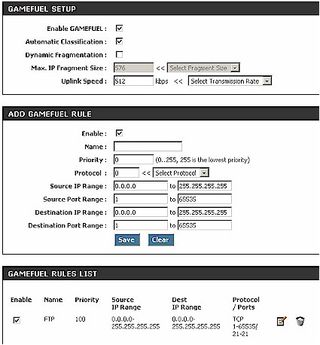Hardware Router Need To Know 2006
Everyone with a high-speed Internet connection needs a router. So why not learn how to choose the one that best meets your needs? We've updated and expanded our classic Hardware Router Need To Know to help you do just that!
Routing and QoS
Some routers have non-NAT routing features. This means that instead of manipulating data so that many computers can share a single IP address, the router can properly direct traffic among all computers on networks that use more than one range of IP addresses. One of the key functions performed is making sure that all computers know the IP addresses of the various network gateways and DNS servers and where to send data that's intended for computers that are on different subnets.
Note that this feature does not solve the problem of getting Microsoft File and Printer sharing to work so that all machines on all subnets can see and communicate with each other. That requires a Domain controller, which you get by either adding a Microsoft-based server or machine running SAMBA.
There are two kinds of additional routing features. Static routing requires that you manually enter subnet information into the router. Dynamic routing uses RIP (Routing Information Protocol) to allow RIP-aware devices to share network routing information automatically.
If this explanation isn't that clear to you, don't worry too much. If your network were complicated enough to require these functions, you probably already know more about them than we do!
Quality of Service (Qos)
QoS is the ability of the router to prioritize the handling of some packets over others. This is most useful for applications requiring "real-time" response, such as gaming, VoIP, and multimedia streaming. It also holds the promise of being able to allow control of the bandwidth allocated to specific users and/or applications. But as I write this in late spring 2006, QoS is still in its infancy as far as most consumer routers are concerned and inconsistently supported.
For example, some of the most expensive MIMO routers such as Netgear's RangeMax 240 have no QoS features at all, while less expensive products such as D-Link's Gaming routers have Ubicom's sophisticated automatic StreamEngine QoS technology (D-Link calls this "GameFuel". But while StreamEngine is slick and works well, it works for upstream traffic only. This makes it useless for keeping little Susie's music downloading habit from dominating the home Internet connection. And as Figure 10 shows, QoS controls have a way to go in order to be user-friendly.
Sign up to get the BEST of Tom’s Guide direct to your inbox.
Upgrade your life with a daily dose of the biggest tech news, lifestyle hacks and our curated analysis. Be the first to know about cutting-edge gadgets and the hottest deals.

Figure 10: D-Link GameFuel QoS settings
The good news is that the emphasis on web-based multimedia applications should push manufacturers in the direction of implementing QoS more consistently and across their product lines. In the meantime, however, don't assume that your router has QoS features.
Tom's Guide upgrades your life by helping you decide what products to buy, finding the best deals and showing you how to get the most out of them and solving problems as they arise. Tom's Guide is here to help you accomplish your goals, find great products without the hassle, get the best deals, discover things others don’t want you to know and save time when problems arise. Visit the About Tom's Guide page for more information and to find out how we test products.
